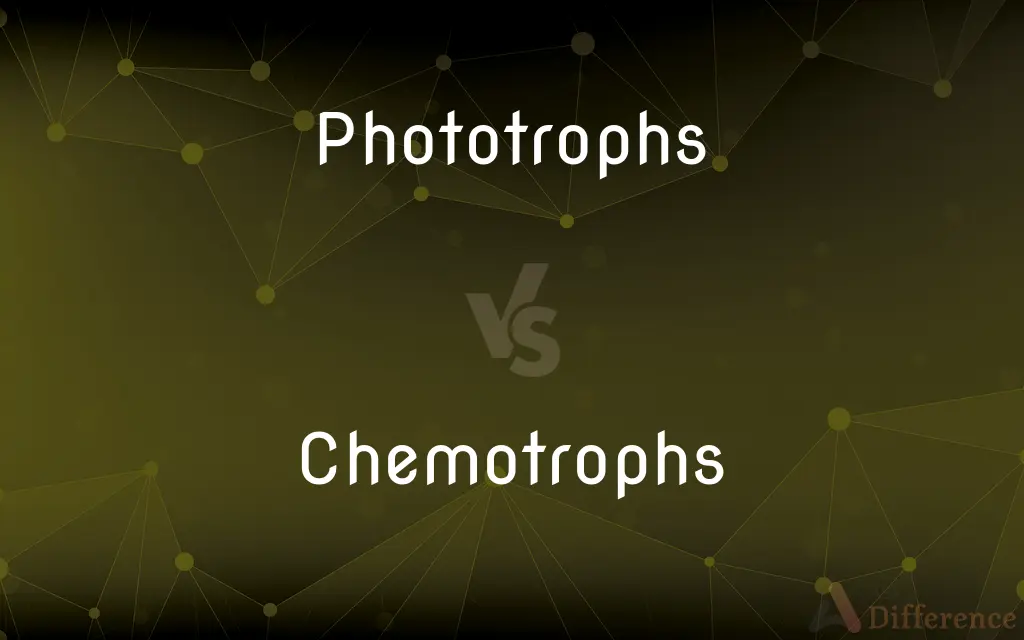Phototrophs vs. Chemotrophs — What's the Difference?
By Tayyaba Rehman — Published on January 3, 2024
Phototrophs gain energy from light, while chemotrophs obtain energy from chemical reactions.

Difference Between Phototrophs and Chemotrophs
Table of Contents
ADVERTISEMENT
Key Differences
Phototrophs are organisms that use light as their primary energy source, transforming it into chemical energy through photosynthesis. They are crucial for life on Earth, as they produce oxygen and form the base of many food chains. Chemotrophs, in contrast, derive their energy from chemical compounds through processes like oxidation or fermentation. They are often found in extreme environments where sunlight is unavailable.
Phototrophs, including plants and certain bacteria, harness sunlight using pigments like chlorophyll. This light energy is then used to convert carbon dioxide and water into glucose and oxygen, a process vital for life on Earth. Chemotrophs, on the other hand, do not rely on light. Instead, they may oxidize inorganic or organic compounds, or even methane, to meet their energy needs. This versatility allows them to thrive in diverse environments, from deep-sea vents to our digestive tracts.
Phototrophs are often at the foundation of ecosystems, providing organic compounds and oxygen through photosynthesis. Their ability to convert light into energy supports diverse life forms. Chemotrophs, particularly those in extreme environments, demonstrate the adaptability of life. They can extract energy from substances like hydrogen sulfide or iron, showcasing the diverse metabolic pathways life has evolved.
Phototrophs primarily include plants, algae, and some bacteria, playing a pivotal role in converting inorganic carbon into organic forms, which then become available to other organisms. Chemotrophs include a wide range of bacteria and archaea, some of which are integral to processes like nutrient cycling, wastewater treatment, and even human health, showcasing the remarkable diversity of life’s energy strategies.
Phototrophs are essential for the Earth's carbon cycle and for maintaining atmospheric oxygen levels. Their photosynthetic activity is a cornerstone of life on Earth. Chemotrophs, especially those in soil and water ecosystems, are critical for recycling nutrients and supporting complex food webs, often in places where light cannot reach, demonstrating the intricate balance of Earth's ecosystems.
ADVERTISEMENT
Comparison Chart
Energy Source
Light
Chemical reactions
Primary Processes
Photosynthesis
Oxidation, fermentation
Common Examples
Plants, algae, cyanobacteria
Bacteria in deep-sea vents, soil microbes
Habitat
Mostly in light-exposed areas
Diverse, including extreme environments
Role in Ecosystems
Foundation of food chains, oxygen production
Nutrient cycling, energy production in dark or extreme places
Compare with Definitions
Phototrophs
Entities primarily using photosynthesis for energy.
Many phototrophs are essential for maintaining oxygen levels on Earth.
Chemotrophs
Organisms deriving energy from chemical reactions.
Certain chemotrophs are crucial for breaking down pollutants.
Phototrophs
Light-dependent energy harvesters.
Phototrophs like plants are pivotal in converting sunlight into usable energy.
Chemotrophs
Organisms independent of sunlight for energy.
Chemotrophs demonstrate life’s adaptability in extreme environments.
Phototrophs
Life forms transforming solar energy into biological energy.
Phototrophs ensure a continual supply of oxygen and organic materials.
Chemotrophs
Energy harvesters from inorganic or organic substances.
Chemotrophs in our gut aid in digestion and health.
Phototrophs
Organisms forming the base of many food webs.
In oceans, phytoplankton, tiny phototrophs, are primary producers.
Chemotrophs
Life forms thriving on chemical compounds for energy.
In deep-sea vents, chemotrophs form the basis of unique ecosystems.
Phototrophs
Organisms that convert light energy into chemical energy.
Algae, as phototrophs, play a crucial role in aquatic ecosystems.
Chemotrophs
Entities utilizing oxidation or fermentation for energy.
Some soil chemotrophs help in nutrient recycling.
Phototrophs
An organism that is capable of using light energy to synthesize sugars and other organic molecules from carbon dioxide. Green plants, algae, and cyanobacteria are phototrophs. Also called photoautotroph.
Chemotrophs
Plural of chemotroph
Phototrophs
Plural of phototroph
Common Curiosities
What are phototrophs?
Phototrophs are organisms that obtain energy from light, primarily through photosynthesis.
Do phototrophs produce oxygen?
Yes, many phototrophs, like plants and algae, produce oxygen as a byproduct of photosynthesis.
Are all plants phototrophs?
Almost all plants are phototrophs, relying on sunlight for energy.
What energy sources do chemotrophs use?
Chemotrophs use various chemical reactions, often involving oxidation of inorganic or organic compounds.
How do phototrophs impact ecosystems?
Phototrophs form the foundation of many food chains and contribute to oxygen and nutrient cycles.
What are chemotrophs?
Chemotrophs are organisms that derive energy from chemical reactions, not depending on light.
Are all chemotrophs found in extreme environments?
While many thrive in extreme conditions, chemotrophs also exist in more common environments like soil.
Can chemotrophs be beneficial to humans?
Yes, some chemotrophs aid in processes like wastewater treatment and nutrient cycling.
Are chemotrophs important for soil health?
Yes, many chemotrophs in soil play vital roles in decomposition and nutrient availability.
Can phototrophs exist in dark environments?
Generally, phototrophs need light to survive, making dark environments unsuitable for them.
Do phototrophs require carbon dioxide?
Yes, phototrophs use carbon dioxide in photosynthesis to produce oxygen and organic compounds.
What’s an example of a chemotroph?
Bacteria in deep-sea vents are common examples of chemotrophs.
Can phototrophs live in water?
Yes, many phototrophs, like algae, thrive in aquatic environments.
Do phototrophs have a role in climate regulation?
Yes, by absorbing carbon dioxide, phototrophs help in regulating atmospheric composition and climate.
Can chemotrophs produce energy without oxygen?
Yes, some chemotrophs can produce energy anaerobically, without oxygen.
Share Your Discovery

Previous Comparison
ERP vs. SAP
Next Comparison
Transitive Verb vs. Intransitive VerbAuthor Spotlight
Written by
Tayyaba RehmanTayyaba Rehman is a distinguished writer, currently serving as a primary contributor to askdifference.com. As a researcher in semantics and etymology, Tayyaba's passion for the complexity of languages and their distinctions has found a perfect home on the platform. Tayyaba delves into the intricacies of language, distinguishing between commonly confused words and phrases, thereby providing clarity for readers worldwide.














































